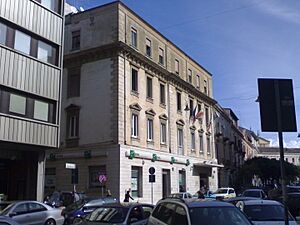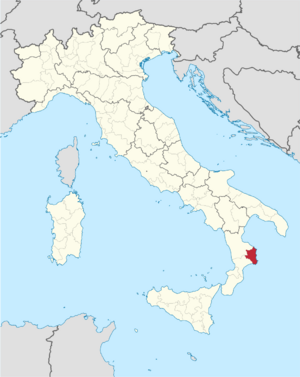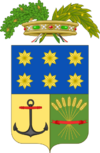Province of Crotone facts for kids
Quick facts for kids
Province of Crotone
|
|||
|---|---|---|---|

The provincial seat
|
|||
|
|||

Map highlighting the location of the province of Crotone in Italy
|
|||
| Country | |||
| Region | Calabria | ||
| Capital(s) | Crotone | ||
| Comuni | 27 | ||
| Area | |||
| • Total | 1,717 km2 (663 sq mi) | ||
| Population
(1 January 2019)
|
|||
| • Total | 174,890 | ||
| • Density | 101.86/km2 (263.81/sq mi) | ||
| GDP | |||
| • Total | €2.733 billion (2015) | ||
| • Per capita | €15,660 (2015) | ||
| Time zone | UTC+1 (CET) | ||
| • Summer (DST) | UTC+2 (CEST) | ||
| Postal code |
88900; 888xx
|
||
| Telephone prefix | 0962, 0984 | ||
| Vehicle registration | KR | ||
| ISTAT | 101 | ||
The Province of Crotone (which in Italian is provincia di Crotone) is a cool area in the Calabria region of southern Italy. It was created in 1992 from part of the province of Catanzaro. Its main city, or capital, is Crotone. This province shares borders with the Province of Cosenza and the Province of Catanzaro. It also has a long coastline along the Ionian Sea.
Inside the province, you can find the mountain Pizzuta and parts of the Sila National Park. There's also Montagnella Park and the Giglietto Valley. The city of Crotone itself was founded a very long time ago, in 710 BCE. It even took part in the Second Punic War against the Roman Republic. The province has 27 smaller towns or areas called comuni.
Contents
History of Crotone Province
Ancient Settlements and Greek Influence
The land around Capo Colonna, which is the easternmost point of the province, has many old remains from the Stone Age. People have found lots of Neolithic pottery there. This shows that people lived here a very long time ago.
Around 710 BC, Greek settlers came to the coasts of Calabria. They founded the city of Crotone, calling it Kroton. This city grew very quickly. By 500 BC, it had between 50,000 and 80,000 people.
Famous People and Important Events
A famous wrestler named Milo of Croton was born in Crotone in the 6th century BC. The city was known for its amazing athletes and produced many Olympic champions.
Around 530 BC, the famous thinker Pythagoras moved to Croton. There was also an important medical school in the area at that time. Crotone became a very important port city. It even conquered the city of Sybaris with Milo leading the way.
Later, Pyrrhus of Epirus controlled the city. But eventually, it became part of the Roman Republic. During the Second Punic War, Crotone rebelled and fought against its Roman rulers.
Modern Province Formation
The Province of Crotone as we know it today was officially created in 1992. Before that, its land was part of the province of Catanzaro.
Geography of Crotone Province
Location and Borders
The Province of Crotone is one of five provinces in the Calabria region. Calabria is located in southern Italy. To the northwest, it borders the Province of Cosenza. To the southwest, it borders the Province of Catanzaro.
To the south and east, the province has a beautiful coastline. This coast is part of the Gulf of Taranto, which is a section of the Mediterranean Sea.
Natural Landscapes
The northwestern part of Crotone is high up on a plateau called La Sila. This area includes part of the Sila National Park. It's a wild and rugged place with open heathland. You can find many types of trees here, like pine, oak, beech, and fir.
In the higher areas, farmers grow chestnuts and olives. Most of the province is a lower area used for farming. Here, you'll see orchards full of citrus fruits and many vineyards. The rivers in this province are usually short, and many of them dry up during the summer.
Tourism and Historic Sites
Exploring Crotone City
The city of Crotone has a very long history and many interesting places to visit. Its main cathedral was built between the 9th and 11th centuries AD. However, it has been changed many times over the years.
The 16th-century castle of Charles V is now home to the local museum. There's also an older castle on an island just off the coast. You can only reach this ancient castle by walking to it. Near the town, you can find the remains of the Greek temple of Hera Lacinia. This was once the most important temple in Magna Graecia.
Santa Severina's Ancient Charm
The historic town of Santa Severina dates back to the 9th century BC. An ancient Italian tribe called the Enotri lived here first. Later, it became an important trading center for the Byzantine Empire.
Santa Severina is built on top of a steep hill, with its castle at the very top. This castle is one of the best-preserved Norman buildings in the region. Today, it holds the Archaeological Museum of Castles and Fortifications in Calabria. In the main square, you'll see the Cathedral of Saint Anastasia, built in 1274. Nearby is the Baptistry, a beautiful example of Byzantine architecture from the 7th to 9th centuries. It's probably the oldest building of its kind in Calabria. On the other side of the castle is the 11th-century Church of Santo Filomena, another lovely Byzantine building.
Other Historic Towns
Pallagorio's Rich Past
Pallagorio is another very old town. The "Cave of St. Maurice" was used by people in Neolithic times. Greek settlers came here around the 7th century BC. Roman settlers also arrived centuries later, and you can still see traces of their old villas near the river. In the Middle Ages, the village here was known as "San Giovanni in Palagorio." Today, it has many interesting churches and chapels.
Umbriatico's Hilltop History
Umbriatico was founded by the Oenotrians before Greek settlers arrived. It is located on a rocky hill and you can reach it by a bridge over the river. During the Second Punic War, Umbriatico had a strong defensive wall. However, this didn't stop the Romans from attacking it and harming its citizens. The Cathedral of San Donato has a crypt that was originally a Greek temple, with old Doric columns.
See also
 In Spanish: Provincia de Crotona para niños
In Spanish: Provincia de Crotona para niños



